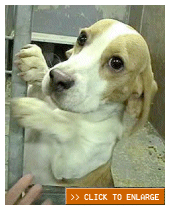Many species of animals fall victim to suffering and misery inside laboratories: monkeys, pigs, dogs, cats, hamsters, rabbits, frogs, squirrels, baboons, horses, guinea pigs, mice, sheep, birds, iguanas, rats, chimpanzees, gerbils, woodchucks, ferrets, cows, and others.
Rabbits are routinely used because they are docile and thus easy to manipulate.1 Mice are exploited even more often since they are inexpensive and easy to handle. The federal Animal Welfare Act (AWA) is meant to secure the basic rights of animals in laboratories, such as access to food and water. But many animals, such as reptiles, birds, rats and mice are intentionally excluded.2 These animals are given absolutely no legal protection from neglect and abuse.
WHERE THE ANIMALS COME FROM
Over 50,000 primates die in U.S. laboratories ever year.3 Some of these are bred in captivity; others are captured in the jungles of Africa and Southeast Asia. Wild-caught primates are imported by commercial dealers. These individuals “buy” trapped animals, box them in small crates with little to no food or water, and cargo ship them around the world. Many die in the process.4,5,6
Click here to learn how other animals are obtained.
Even when not being poisoned or mutilated in actual experiments, the lives of animals in laboratories are nightmarish. Many spend the entirety of their lives in small, barren metal cages. The isolation and boredom alone often cause social animals to become psychotic.
Animals in laboratories are viewed merely as objects. Their ability to suffer and feel is denied or disregarded. As mere “test subjects” they are handled roughly, with no thought to their distress, fear or pain. When not being experimented on, these animals still enjoy no comfort at all, sleeping on cement or metal flooring.
Click here to learn what happens to animals in labs.
WE GIVE THEM NAMES... THEY GIVE THEM NUMBERS
A parallel view of the animals we love and the animals that scientists use in experiments.
This is the indifferent trick of fate; one animal was rescued, held in caring arms, given a home and loved. The other was taken, imprisoned and subject to torment and torture.
We call one by name and love them.
They refer to the other by test subject number and destroy them. Click here to see the comparison.
1. Ron Banks, "Rabbits: Models and Research Applications," United States Army Medical Research Institute of Infectious Diseases (October 1989).
2. Animal Welfare Act, Title 7, Chapter 54, section 2132(g).
3. United States Department of Agriculture, Animal and Plant Health Inspection Service, "Annual Report of Enforcement," (2004).
4. "A Study of Behavioral Responses of Non-human Primates to Air Transport and Rehousing," Laboratory Animals 38 (2004): 119-132.
5. British Union Against Vivisection, "Primates in Transit," (June 2004).
6. Mark J. Prescott and Maggy Jennings, Research Animals Department, RSPCA, "Ethical and Welfare Implications of the Acquisition and Transport of Non-human Primates for Use in Research and Testing," (2004).
This website is dedicated to the memory of Matt Fancera.











